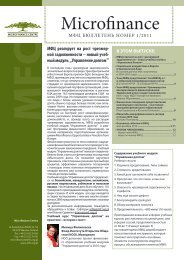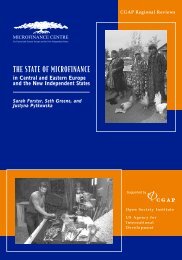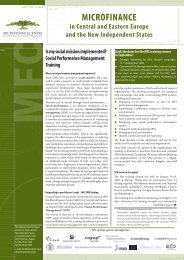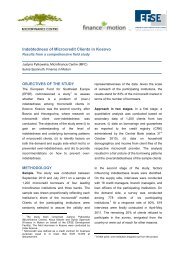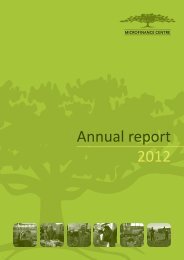Value Chains research report Tajikistan final - Microfinance Centre
Value Chains research report Tajikistan final - Microfinance Centre
Value Chains research report Tajikistan final - Microfinance Centre
You also want an ePaper? Increase the reach of your titles
YUMPU automatically turns print PDFs into web optimized ePapers that Google loves.
The transaction between the Input dealer until consumers request financial<br />
interventions, which help VC players be able to operate in condition of strong<br />
competition, and effectively puts consumers in control - they demand better quality<br />
produce at lower prices. Such produce can only be delivered if all actors in production<br />
work efficiently and cooperate effectively.<br />
The idea of <strong>Value</strong> Chain Finance is very important, but should be developed in<br />
combinations of knowledge improvement and transferring know-how. The VCF help<br />
only under the reality that the relationship between producers and processors is no<br />
longer antagonistic (one tries to get prices up, the other tries to reduce prices), and<br />
collaboration bring synergy. Both groups should find ways to cooperate in order to<br />
compete with a <strong>Value</strong> Chain from another area or country and financing all activities<br />
which bring benefits to both players (like financing inputs to farmers through input<br />
dealer, or financing the increasing capacity of processors to be able process more raw<br />
materials and to increase quality and to reduce transaction costs. Goal of using VCF<br />
analyses to finding financial schemes/products are thus created in order to provide<br />
these assurances at all stages of the production process.<br />
The VCF is an efficient tools for opening the bottlenecks and development<br />
production, processing and supply products for internal and export markets. More<br />
detailed about VC actors and need for their financing we provided below.<br />
4. Current engagement of MFIs in financing VC actors.<br />
Currently there are 122 microfinance institutions operates in <strong>Tajikistan</strong> 2 , including<br />
34 microcredit deposit organizations, 43 microlending organizations and 45<br />
microlending funds. The quality and quantity of microfinance organizations is<br />
continuously improving, and so does the number of loans disbursed by these<br />
organizations. The entire microfinance sector is serving more than 550,360,468 somoni<br />
(MFIs AMFOT members) and 141,914 clients. According to AMFOT bulleting only top<br />
13 largest MFOs in <strong>Tajikistan</strong> have more than 461,122,115 somoni loan portfolio<br />
between them, serving 115,973 clients.<br />
All these microfinance institutions are typically engaged in agriculture financing,<br />
which is already high element of VCF. From other side MFIs finance agribusiness<br />
activity involved in supply inputs, seeds, machinery and processing operations by<br />
searching clients. Also MFIs finance construction and repairing existing warehouses<br />
and storages, finance the working capital for wholesalers and retailers of agricultural<br />
products. There are also some MFIs which serve processors (dairy, grain mill), input<br />
(seeds, fertilizers) producers and traders as well as procurement companies (see table<br />
below). These institutions managed to extend their services beyond the producers<br />
thanks to the external guidance and technical assistance.<br />
2 National Bank Web site provides names, contact persons, addresses and telephones of these organizations:<br />
http://nbt.tj/ru/banking_system/non_banking_institutions.php<br />
11




